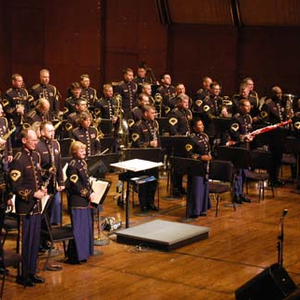
| Trackimage | Playbut | Trackname | Playbut | Trackname |
|---|---|---|---|---|
| 84668187 | Play | The Battle Hymn of the Republi | 00:00 Tools | |
| 84668189 | Play | The Star-Spangled Banner | 00:00 Tools | |
| 84668188 | Play | The Battle Hymn of the Republic | 02:21 Tools | |
| 84668190 | Play | Battle Hymn of the Republic | 00:00 Tools | |
| 84668191 | Play | Gold Bless America | 00:00 Tools | |
| 84668192 | Play | The Stars & Stripes Forever | 00:00 Tools | |
| 84668193 | Play | School Boy Crush | 00:00 Tools | |
| 84668194 | Play | The Star Spangled Banner | 00:00 Tools | |
| 84668196 | Play | National Emblem March | 00:00 Tools | |
| 84668195 | Play | Army Strong(Army Band Version) | 00:00 Tools | |
| 88631583 | Play | Star Spangled Banner (Instrumental) | 00:00 Tools |

-
- 1,289
- plays
-
- 240
- listners
-
- 1289
- top track count
From the US Army Band Website: "Since 1922, The United States Army Band “Pershing’s Own” has maintained a tradition of excellence as one of the premier musical organizations of The United States Army. The Band was founded in 1922 by Army Chief of Staff General John J. “Black Jack” Pershing to emulate European military bands he heard during World War I. The U.S. Army Band continues to play an important role in events of national and international significance, staging performances from the battlefields of World War II to our Nation’s Capital. During its early years, the Band became widely known and critically acclaimed for radio broadcasts featured on several networks, including RCA, CBS, and the Mutual Broadcasting Network. The Band also completed four national tours between 1928 and 1931 and became highly respected for its performances during a trip to Spain for the Ibero-American Exposition in spring 1929. In June 1943, the Band was called overseas to perform first in North Africa and then battle-weary Europe, returning to U.S. soil in June 1945. The Band received a battle streamer for their efforts during the Rhineland Campaign and is the only Washington-based military band to have participated in a theater of foreign combat operations. The period after World War II saw the Band expand in scope and diversity to keep pace with an increased demand for numerous and specialized assignments. The United States Army Ceremonial Band, The United States Army Chorus, The United States Army Herald Trumpets, and The United States Army Strings were established as regular performing units during this time. This period also saw the Band perform with numerous well-known artists and composers, many as part of the very successful Freedom Sings concert series that started in 1950 and continued for several years. Notables include Metropolitan Opera bass Jerome Hines, composers Paul Hindemith and Percy Grainger, and the pianist duo Whittmore and Lowe. Similarly, several well-known entertainers and recording artists were band members during this period. Eddie Fisher, Robert Dini, and Steve Lawrence were very popular during the 1950s, as were harpist Lloyd Lindroth, future Metropolitan Opera tenor, George Shirley, and announcer Charles Osgood. Throughout the 60s, 70s, and 80s, The U.S. Army Band continued to perform and serve with distinction. In 1963, teh Band participated in the funeral of President John F. Kennedy with U.S. Army Band Bugler Keith Clark performing Taps at the graveside service in Arlington National Cemetery. Brucker Hall, the Band’s training and performance facility, was constructed in the mid-1970s. Also during this era, The United States Army Blues Jazz Ensemble, The United States Army Chorale, and The Unites States Army Brass Band were officially established as regular performing ensembles. An official Coat of Arms and distinctive uniforms were approved to reflect the Band’s increasing visibility at events of national significance, including the visit of Emperor Hirohito to Alaska with President Nixon, the national Bicentennial Celebration, the Lake Placid Winter Olympics, the return of the former U.S. hostages from Iran, the World’s Fair in Knoxville, Tennessee, and the 1984 Olympic Games in Los Angeles. The Band has performed in Canada, Japan and Australia as well as in several of the nation’s prominent concert halls, such as Carnegie Hall, Radio City Music Hall, the Guggenheim Band Shell and Avery Fisher Hall at Lincoln Center in New York, the Hollywood Bowl, and the Hatch Shell in Boston. In 1984, the Band recorded and participated in the filming of Francis Ford Coppolla’s movie Gardens Of Stone. The Band continued its tradition of excellence with performances at the 1990 Economic Summit in Houston, the Desert Storm Victory Parade in New York, and Reba McEntire’s Christmas Special in Nashville. The Band performed in Sweden, The Netherlands, Turkey, Novia Scotia, and Scotland that included a concert of International Goodwill with the Soviet Union’s Navy Band of Moscow in Stockholm. In November 1997, The U.S. Army Band “Pershing’s Own” culminated its rich 75-year history with a grand concert at Carnegie Hall in New York. Guest artists included Walter Cronkite, Charles Osgood, and Metropolitan Opera stars Roberta Peters and John Cheek. In June 2005, The U.S. Army Band welcomed Colonel Thomas Rotondi, Jr., former Commander and Conductor of the U.S. Military Academy Band at West Point, New York. Originally from Chicago Heights, Illinois, Col. Rotondi is the U.S. Army Band’s eighth Leader and Commander." Read more on Last.fm. User-contributed text is available under the Creative Commons By-SA License; additional terms may apply.